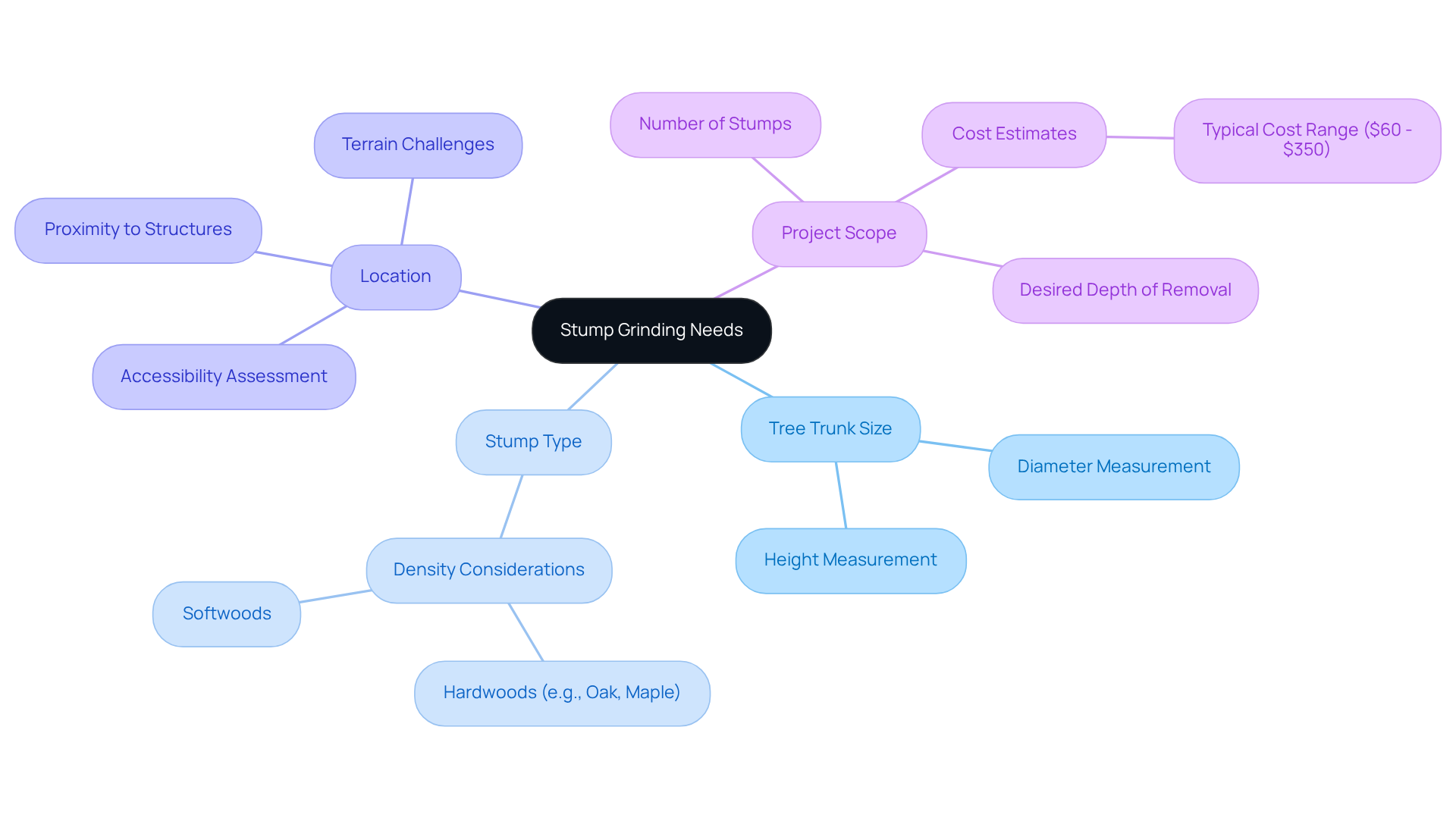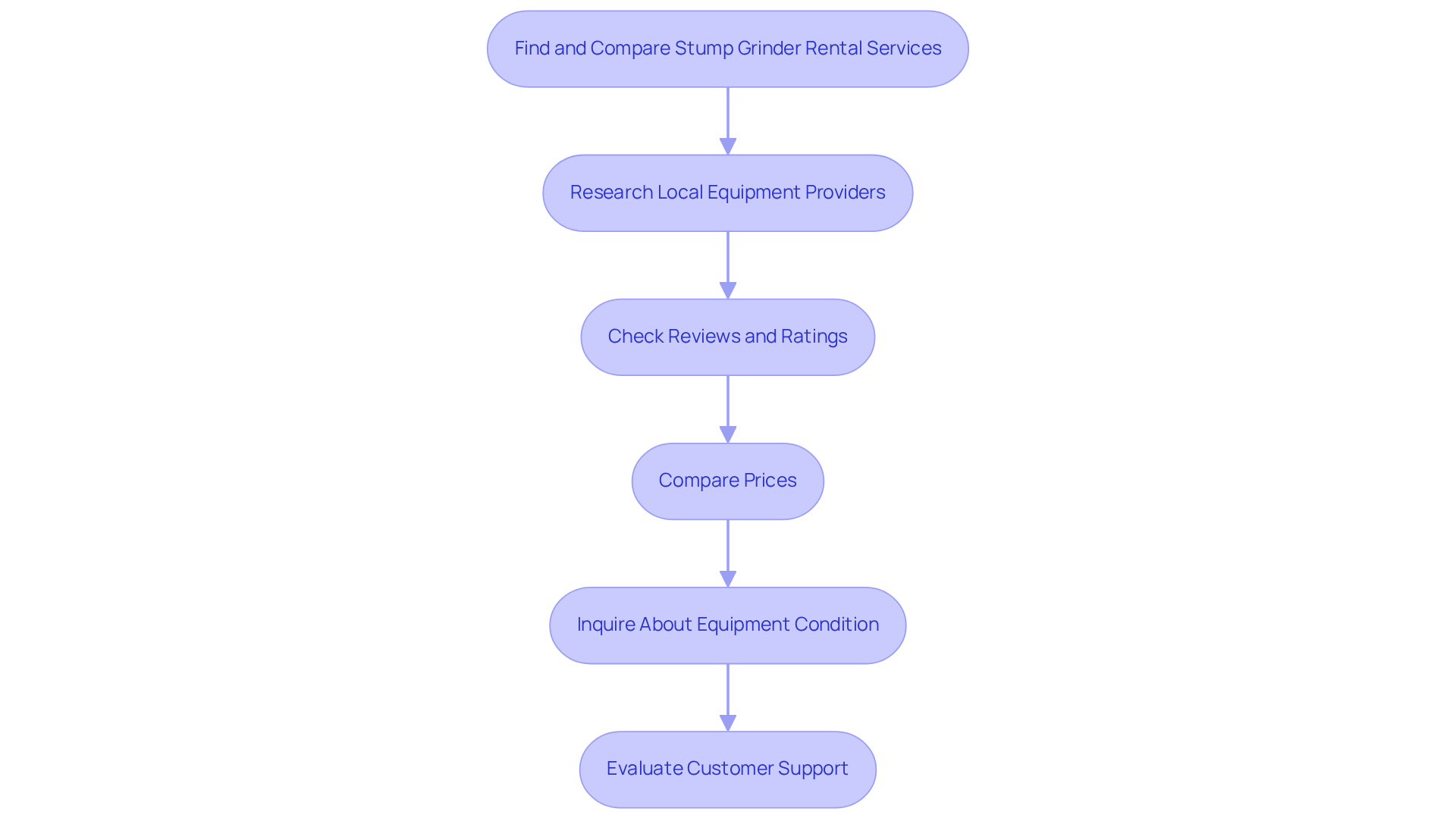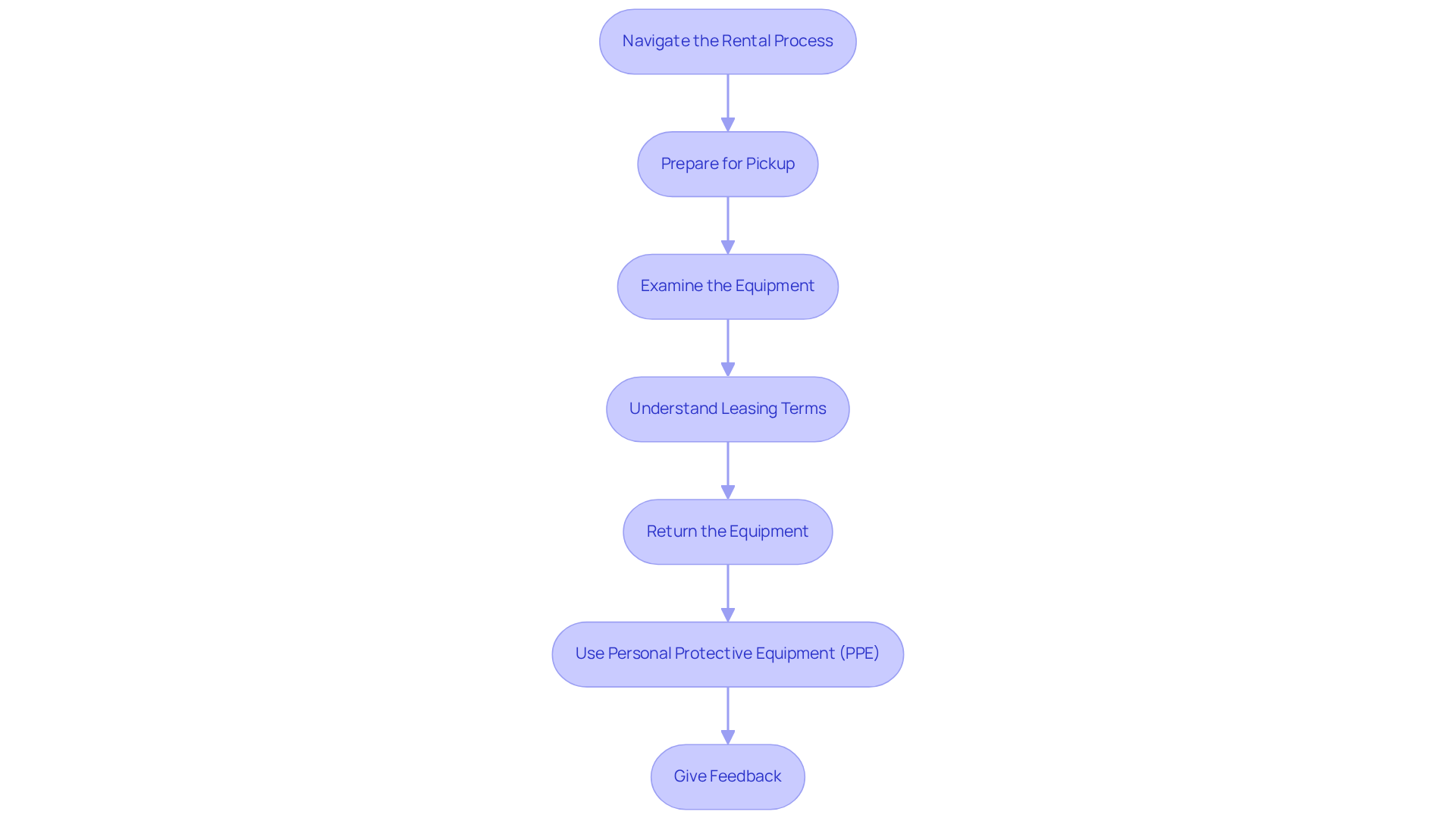Overview
To achieve successful stump grinder rental, it is essential to evaluate the size and type of the tree stump, select the appropriate equipment, and conduct thorough research on rental services. This process starts with a clear understanding of the tree trunk dimensions and the machine power requirements necessary for effective grinding. Furthermore, comparing local rental providers is crucial to ensure optimal performance and cost-effectiveness. By focusing on these key factors, you can make informed decisions that lead to a successful rental experience.
Key Highlights:
- Evaluate tree trunk size, type, location, and project scope before renting a stump grinder.
- Larger tree trunks require more powerful machines; hardwoods like oak need at least 14 HP.
- Choose between wheeled and tracked stump grinders based on manoeuvrability and stability needs.
- Confirm that the grinder can achieve a cutting depth of 10 to 12 inches for effective root clearance.
- Rental costs for stump grinders range from $80 to $400 daily; consider all associated expenses.
- Research local rental providers, cheque reviews, compare prices, and inquire about equipment condition.
- Inspect the equipment before pickup, understand leasing terms, and clean the grinder before return.
- Always use personal protective equipment (PPE) for safety during operation.
Introduction
Navigating the intricacies of stump grinding can be challenging for many, particularly when it comes to selecting the appropriate equipment for rental. However, with a strategic approach, this process can be streamlined to ensure both efficiency and satisfaction.
This guide provides essential insights into:
- Choosing the ideal stump grinder
- Comparing rental services
- Mastering the rental process itself
But what are the implications of selecting the wrong equipment? Addressing this concern is crucial, as it could lead to unexpected challenges and costs.
By exploring the fundamental steps for successful big stump grinder rental, you can significantly enhance your project's outcome, transforming potential frustrations into a smooth and efficient experience.
Understand Your Stump Grinding Needs
Before renting a stump grinder, it is essential to evaluate several key factors that will significantly impact your experience:
- Tree Trunk Size: Begin by accurately measuring the diameter and height of the trunk. Larger tree bases typically necessitate stronger machinery to ensure efficient removal. In Texas, average stump diameters can vary considerably among common tree species, making it crucial to understand these dimensions.
- Stump Type: Different tree species possess varying densities, which can affect the grinding process. For instance, hardwoods like oak and maple are denser and may require more powerful tools compared to softer woods. As noted by arborist Adrian Nita, "Understanding the density of the tree species is vital for selecting the appropriate equipment."
- Location: Assess the accessibility of the tree remnant. If it is located in a confined area or near structures, a more compact grinder may be necessary to navigate the space effectively. Additionally, remnants situated in challenging landscapes or far from parking locations could incur extra expenses, which should be factored into your budget.
- Project Scope: Determine the number of tree remnants you need to process and the desired depth of removal. Tree removal costs typically range from $140 to $450, depending on the size of the root. This information is critical for selecting the right equipment and estimating usage duration.
By thoroughly understanding these factors, you can make informed decisions that enhance your rental experience and ensure successful grinding.

Choose the Right Stump Grinder for Your Project
When selecting a big stump grinder rental, several key factors must be considered to ensure optimal performance and efficiency.
- Power and Size: For small tree remnants, a machine with around 6.5 to 15 HP is typically adequate. However, larger trunks, particularly those exceeding 16 inches in diameter, may necessitate a more powerful machine, ideally 20 HP or more. As an expert notes, "When you're dealing with tougher wood types like oak or maple, you'll want more horsepower—at least 14 HP and up." It is vital to confirm that the machine can handle the diameter and depth of the base, as increased horsepower leads to enhanced efficiency and speed in tackling harder wood varieties.
- Type of Equipment: The choice between wheeled and tracked stump machines can significantly impact performance. Wheeled tools are generally more maneuverable, making them suitable for residential projects with tight spaces. In contrast, tracked machines offer improved stability on uneven surfaces, advantageous for larger or more intricate tasks. Performance statistics indicate that tracked machines excel in stability, especially on slopes or rough ground.
- Cutting Depth: Verify that the tool can achieve the desired cutting depth, which is typically between 10 to 12 inches below ground level for most residential applications. This depth is essential for effective root clearance and ensuring a smooth finish for reseeding or mulching.
- Ease of Use: Look for features that enhance usability, such as adjustable handles and intuitive controls. These features are particularly important for novice users, as they can significantly reduce the learning curve and improve overall safety during operation. Additionally, safety considerations are paramount; always wear appropriate protective gear and follow the manufacturer's instructions.
- Budget Considerations: The rental expenses for a big stump grinder rental can range from $80 to $400 daily, depending on the size and type. It is essential to evaluate your budget for a tree cutter, including purchase price, maintenance, and fuel expenses. By carefully assessing these elements, you can choose the appropriate grinding machine for your project, resulting in a more effective and successful grinding experience.

Find and Compare Stump Grinder Rental Services
To effectively find and compare stump grinder rental services, consider the following steps:
- Research Local Equipment Providers: Start by identifying equipment leasing companies in your vicinity, such as EZ Equipment Rental, recognized for its extensive selection of tools and equipment. This foundational step sets the stage for informed decision-making.
- Check Reviews and Ratings: Investigate customer feedback across various platforms to assess the reliability and quality of service provided by different leasing companies. Positive feedback can serve as a strong indicator of a trustworthy provider, reinforcing your confidence in the selection process.
- Compare Prices: Obtain quotes from various leasing services. It is essential to evaluate not only the leasing price but also any additional fees for delivery, pickup, and cleaning, as these can significantly impact the total cost. Understanding the complete financial picture is crucial for making a sound decision.
- Inquire About Equipment Condition: Ask about the maintenance history of the stump grinders. Using a big stump grinder rental that is well-maintained is vital for ensuring safety and operational efficiency during your project. This inquiry can help you avoid potential issues and enhance your overall experience.
- Evaluate Customer Support: Assess the level of customer service provided. A company that offers extensive guidance and support can greatly improve your leasing experience, ensuring you have the necessary assistance throughout the process.
By dedicating time to compare leasing services, you can select a provider that aligns with your specific needs and expectations, ultimately leading to a successful leasing experience.

Navigate the Rental Process: Pickup and Return
To successfully navigate the rental process for stump grinders, adhere to the following guidelines:
- Prepare for Pickup: Ensure you have a valid ID and a credit card ready for the transaction. Verify the pickup time and place with the leasing company to prevent any last-minute problems.
- Examine the Equipment: Prior to departing from the leasing facility, carry out a comprehensive check of the grinder. Look for any existing damage and verify that it is in good working condition. Document any issues you find to prevent disputes when returning the equipment. Regular inspections are crucial, as they can reveal common issues that may affect performance. Remember, regular inspections should be done at the beginning and end of every tenancy.
- Understand Leasing Terms: Familiarize yourself with the lease agreement for the big stump grinder rental, paying close attention to the duration, fees, and policies regarding fuel and cleaning. Knowing these details can help you avoid unexpected charges. For example, grinding tree remnants is typically more affordable than complete removal of the base, with the national average price for grinding being roughly $313. Understanding how your rental fees align with this figure is essential for budgeting.
- Return the Equipment: Clean the cutting machine before giving it back to avoid extra cleaning charges. Ensure that it is returned on time to prevent late fees, which can add unnecessary costs to your project. Be aware that rural tree grinding projects may incur additional mileage fees due to distance from the service provider's location.
- Use Personal Protective Equipment (PPE): Always prioritize safety by wearing suitable PPE, including eye protection, safety shoes, and gloves when using the grinder.
- Give Feedback: After the lease, think about offering feedback to the leasing company. This not only helps improve their services but also assists future customers in making informed decisions.
By following these steps, you can ensure a hassle-free rental experience and maximize the efficiency of your stump grinding project.

Conclusion
Before embarking on a stump grinding project, understanding the essential steps for a successful rental experience is crucial. By evaluating your specific needs, selecting the right equipment, comparing rental services, and navigating the rental process effectively, you can ensure that the task is completed efficiently and safely.
Key considerations include:
- Assessing the size and type of the stump
- Choosing an appropriate grinder based on power and cutting depth
- Diligently researching rental providers to find the best fit
Additionally, being informed about the pickup and return procedures can help avoid unexpected fees and enhance overall satisfaction with the rental experience.
Ultimately, taking the time to prepare and educate yourself on the nuances of stump grinder rentals not only streamlines the process but also contributes to a successful project outcome. Whether tackling a single stump or multiple remnants, informed decisions will lead to a smoother operation and greater peace of mind throughout the endeavor.
Frequently Asked Questions
What should I evaluate before renting a stump grinder?
Before renting a stump grinder, you should evaluate the tree trunk size, stump type, location, and project scope to ensure you select the appropriate equipment and enhance your rental experience.
How do I measure the tree trunk size?
Measure the diameter and height of the trunk to determine the size. Larger tree bases typically require stronger machinery for efficient removal.
Why is stump type important when renting a grinder?
Different tree species have varying densities, which can affect the grinding process. Hardwoods like oak and maple are denser and may require more powerful tools compared to softer woods.
How does the location of the stump affect the choice of grinder?
If the stump is in a confined area or near structures, a more compact grinder may be necessary. Additionally, stumps in challenging landscapes or far from parking may incur extra expenses.
What should I consider regarding the project scope?
Determine the number of tree remnants to process and the desired depth of removal. This information is crucial for selecting the right equipment and estimating the duration of use.
What are the typical costs associated with tree removal?
Tree removal costs typically range from $140 to $450, depending on the size of the root. This should be factored into your budget when planning the project.




